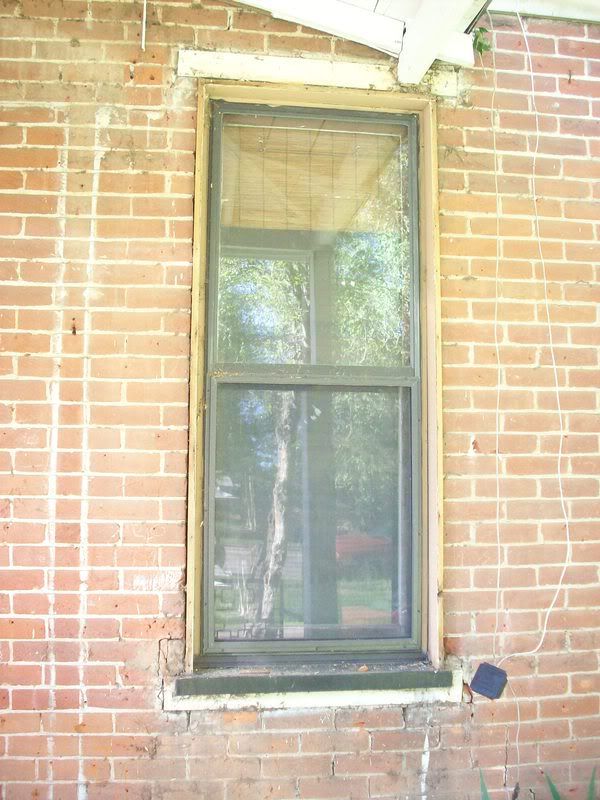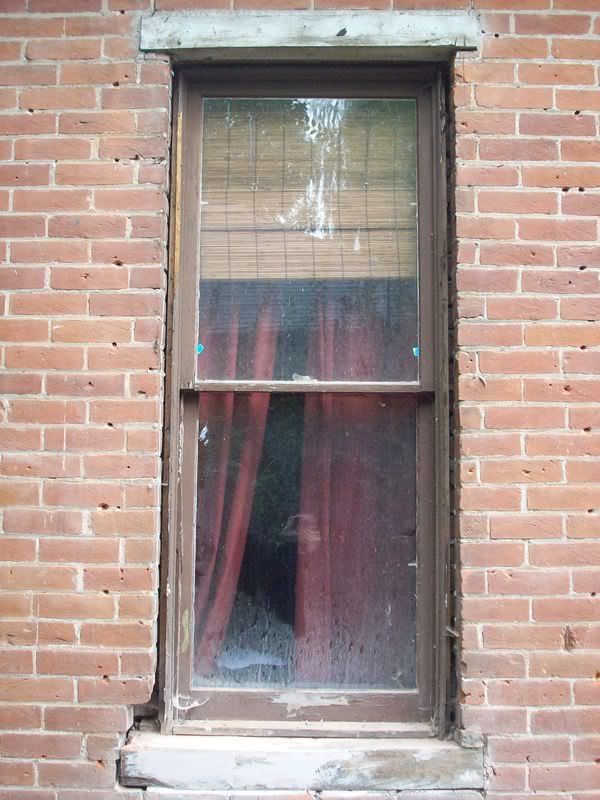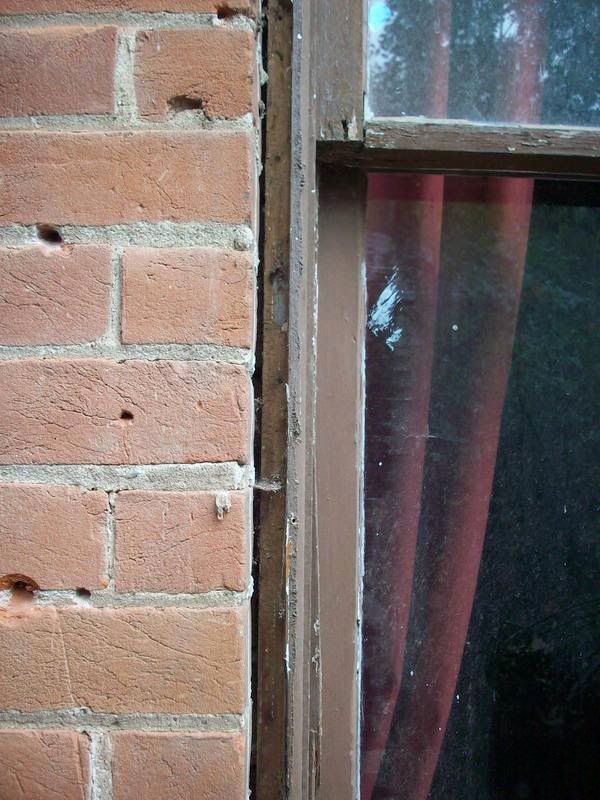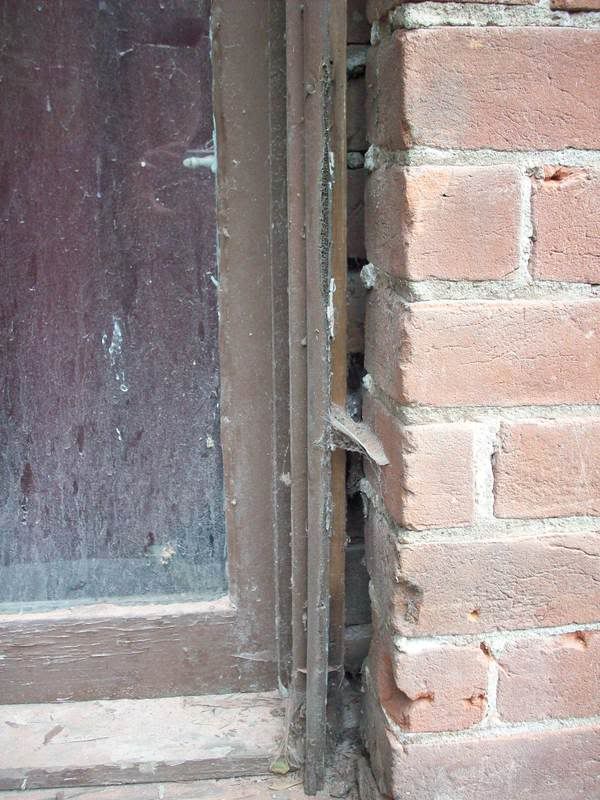
All of the tan trim surrounding the window is not original; much of it is rotting, and it sticks out beyond the brick. It is also not sealed against the brick. The original windows (as seen from neighboring homes) were trimmed out inside the brick opening. We want to remove the tan trim and replace it with something much more suitable.
Here is a window without the tan trim:

This looks much better, and is more historically accurate (again, given surrounding houses). The problem is the gaps:


The quarter round molding currently on the outside of the window frame appears to be newer (it is missing the first layer of paint); it's broken in places and needs replaced anyway. My thought is to pry it off, and replace with a 1 inch deep block molding that will reach from the brick to where the storm windows will start.
Issues that need solving: Do I caulk between this wood molding and the brick? If not, how to I seal between the brick and wood?

13 comments:
Why not caulk?
Are you worried about white caulk showing? I think there is transparent caulk...
I say caulk it! That gap SCREAMS for caulk!
Karen Anne and Jen~
It's too big for caulk~ I do need to bridge the gap with SOMETHING before caulking. It's over an inch. Glad you think it's a good idea between whatever I put there and the brick, though!
You might put some weatherstripping foam in the gap, then cover the gap with the quarter round. Definitely caulk the seams where wood meets masonry. Or you could just use paper towels and a #2 pencil, like my POs did! (Not.)
Oh, I thought you were mostly covering the gap with the "1 inch deep block molding," and the caulk would take care of the rest.
I don't have a good mental picture of what's going on. If what you have there now (besides the "new' quarter round), is the original stuff, why not take a closeup look at your neighbors' old windows and see what was there originally.
Or, maybe I am just confused, I'm a newbie to your blog,and so haven't read the older postings much yet.
Like Jayne, I was thinking the foam; but with either foam or caulk you are going to risk have a really bad appearance. I definitely think you'll need some molding that will eventually go over the gap, but you should fill in the hole first with something that will take the shape of the hole and close up the air gaps (that thing has to be leaking like a sieve right now). After you get the air gap problem solved, then add some additional trim over the gap.
It's Caulk Backing. A 20 ft. long cylinder of foam, comes in three diameters. Ace has packets for a couple bucks. Measure your gap and buy the diameter that's 1/8 inch thicker. Stuff it in and caulk over it. The instructions on the pack give more details.
Later! Barb
I remember when I was working on my windows and found caulking between the brick & wood trim I scraped it off not knowing any better.. Once I'm able to devote some time to continue stripping and repainting the exterior windows I'll have to revisit them. Hopefully I'll notice a difference in my heating bill. :)
I'm with the expanding foam ('great stuff') folks. Pretty much the same idea as the foam strip/caulk backing, but it will get into the nooks & crannies you can't see. Make sure you get the kind that has a little give (there's a rigid kind and a more flexible kind). Squirt a little in because it expands a ton, once totally dry (like the next day) cut it flush with the existing window trim (utility knife), then add the very nice-sounding additional piece of trim. Perhaps also then caulk on top, where the pretty new trim meets the brick? They have lots of colors of caulk now - I'm a HUGE fan of the dark brown for non-perfect dark corners of our interior mouldings! Or you can get paintable and match it to the trim.
Ditto what Sarah just wrote. This is exactly what expanding foam is made for. Good luck!
Hi Jennifer, I completely agree with those who said expanding foam or the foam strip to fill the gap and help your heating bills. Then the wood sealed with caulking and then the whole thing painted. The brick is what will make the job more difficult. Attaching to brick is never as easy as wood - Your Onlinehandyman
I would use expanding foam under the new trim piece, but the Minimal expanding foam. Some of that stuff is really strong and could push your window out of square. (according to the guys on This Old House)
Do yourself a favour and invest in a foam dispensing gun (your local home store has them), it may seem expensive but you will save money in the long run (I wish we had bought ours at the beginning of our renovation). You screw in a cannister of spray foam and you have full control over dispensing the foam. Normally a can of foam (like Great Stuff) has to be used all at once and is messy. The foam gun is a precision tool. Best of all you don't have to empty the can, you can stop, wipe off the nozzle and use it again tomorrow (or next week) the foam doesn't harden in the nozzle.
After filling the gaps with foam (as others have said, don't overfill or you can warp your windowframes -- use low expanding foam) and after it has cured you can cut away the excess with an xacto knife.
We have a 120 yr old victorian and our windows are trimmed with a large 1" quarter-round between the window and the brick. Any remaining gap is caulked. I really like the new 50yr elastomeric latex caulk (dynaflex -- the clear is supposed to be best).
Best of luck!
Post a Comment